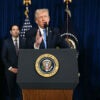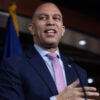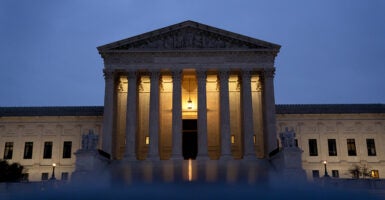It’s time for the Supreme Court to jettison the doctrine known as Chevron deference, which forces federal courts to surrender their judicial function to the unaccountable bureaucrats of the administrative state.
This past January, the high court heard arguments in two cases—Loper Bright Enterprises v. Raimondo and Relentless Inc. v. Commerce Department—that present the opportunity to do just that. A decision in these cases is expected by June.
Article III, Section 1 of the Constitution vests the “judicial Power of the United States” in “one supreme Court” and “such inferior Courts as the Congress may … establish.” As this language makes clear, the Supreme Court is the head of the judicial branch of our federal government. It sits atop the judiciary and superintends the decision-making of lower courts through the opinions it hands down.
The Chevron line of cases is an exercise of the Supreme Court’s superintending role over the judicial branch. It is a set of instructions to the lower courts about how they are to exercise their judicial function when reviewing agency actions that involve formal interpretations of a statute the agency is charged with administering.
Under Chevron, the courts are told to defer to the agency’s interpretation if the part of the statute at issue has more than one plausible reading, even if the court believes there’s a better interpretation that’s more faithful to the statute Congress enacted.
Right away we notice something strange about this instruction: In its unanimous 1984 decision in Chevron U.S.A. Inc. v. Natural Resources Defense Council, the Supreme Court is telling the lower courts to abdicate a portion of their judicial power—to cede it to administrative agencies.
What is judicial power? It’s the power to interpret the law. When it comes to statutes, it’s the final power to decide what the statute requires in particular cases, and thereby determine the meaning of the statute through precedential holdings.
Judiciary Committee reports in the House and Senate accompanying enactment of the Administrative Procedure Act in 1946 both stated that “questions of law are for the courts rather than agencies in the last analysis.”
That means, consistent with the teaching of Marbury v. Madison, that the federal judiciary, and ultimately the Supreme Court, has the final word on what federal statutes mean. This is true even when the courts are reviewing prior interpretations by agencies, such as interpretations reached by an agency in the course of promulgating a regulation to implement the statute.
Chevron is inconsistent with that understanding.
Why is it important for courts to have the final word on questions of law? Because the federal courts are structurally independent and nonbiased.
Under the Constitution, federal judges are appointed for life. Their compensation can’t be reduced while they’re in active service on the bench. And the Judicial Code of Conduct provides that judges will not decide cases in which they’ve had personal involvement or have a personal interest at stake.
In contrast, agency officials who craft interpretations of statutes in support of the agency’s preferred goals are not acting independently or impartially.
So why would the Supreme Court ever have instructed the lower courts to abdicate their judicial function to the agencies?
Well, when it handed down its Chevron opinion in 1984, the Supreme Court was reacting with some exasperation to a persistent pattern of flawed judicial intervention by the lower courts, particularly the U.S. Court of Appeals for the D.C. Circuit, the court that hears the greatest volume of challenges to agency actions.
In the ’60s, ’70s, and early ’80s, the judges of the D.C. Circuit—exemplified by Chief Judges David Bazelon and Skelly Wright—developed a habit of micromanaging the regulatory agendas of federal agencies on the basis of the court’s own preferred policy outcomes.
D.C. Circuit precedents often relied on broad interpretations of “congressional intent,” usually conjured from the vagaries of a statute’s legislative history with no rigorous analysis of text or statutory structure.
Chevron was a potent dose of strong medicine, and it did the trick: With one opinion, the Supreme Court put a stop to the excesses of the D.C. Circuit, without having to correct the many separate errors in each line of precedents on a case-by-case basis.
At the time, conservative officials in the Reagan administration welcomed the Chevron decision because it gave them license to turn away from Jimmy Carter-era regulatory policies and steer the agencies toward President Ronald Reagan’s priorities.
One of those officials had been Anne Gorsuch, then administrator of the Environmental Protection Agency, whose “bubble rule” was at issue in the Chevron case. (In a classic example of what goes around, comes around, she was the mother of current Supreme Court Justice Neil Gorsuch, who has become perhaps the court’s leading skeptic of judicial deference doctrines.)
But presidents and their political appointees weren’t the only ones in the executive branch who benefited from Chevron, of course. It also empowered the many unelected bureaucrats who were beavering away in the swamplands of the administrative state.
And since 1984, we’ve come to know the consequences.
Chevron deference created perverse incentives for all three branches of government. Courts were tempted to find ambiguity in statutory language, so they could avoid the pesky chore of deciphering complex laws.
Agencies, both at the level of political leadership and in the bowels of the bureaucracy, were tempted to innovate and push the bounds of their statutory authorities in reliance on judicial deference. And Congress was tempted to let administrative agencies address the most difficult problems.
Over the years, with the ascendancy of the Chevron framework, the regulatory muscles of the executive branch have become bulked up on steroids, while the other two branches have withered away in important respects. Chevron isn’t the only reason for this, but it’s a significant factor.
Judicial decisions applying Chevron deference have little or no precedential value. Other than declaring some phrase in a statute ambiguous, a court that defers to the agency’s interpretation doesn’t reach any holding on what the statute means, so we lose the consistency that comes from an established judicial interpretation of the law.
And agencies are given a radically wide compass to change their approach to administering statutes—with 180-degree swings from one presidential administration to the next.
Meanwhile, Congress has retired from the field altogether. Rather than do the hard work of legislating to take on major issues of national importance—some perceived as emergencies—Congress lets the agencies deal with the issues under the vague phrasing of decades-old statutes that weren’t enacted to address those issues.
In recent years, the situation has become intolerable.
For example, the EPA has assumed power under the Clean Air Act, a law passed in the 1970s, to regulate carbon dioxide emissions, even though these efforts by the agency don’t fit sensibly within the statutory framework. Through its carbon rules, EPA is forcing revolutionary transformations in the automotive and power industries—something Congress didn’t vote to approve.
And during the coronavirus pandemic, the Occupational Safety and Health Administration, not Congress, tried to impose a vaccine mandate on private industries using workplace safety laws that previously weren’t applied that way.
In response to such out-of-control administrative actions, the Supreme Court developed the so-called Major Questions Doctrine, which assumes, absent a clear and specific grant of authority to an agency, that Congress reserves for itself the power to decide whether to impose new regulatory requirements that carry major economic or political consequences for the nation.
Application of this doctrine is still under development in the high court, but it promises to be one effective way to rein in certain types of agency overreach.
In most cases, though, there’s an easier solution—the good old-fashioned canons of statutory interpretation, applied by independent and impartial courts. The Supreme Court must issue a revised set of instructions to the lower courts, replacing Chevron with a reaffirmation of the role of the judiciary as the final arbiter of all questions of statutory interpretation in the review of agency actions.
Nothing prevents the Supreme Court from making this correction in the two cases currently pending on its docket. Chevron is an exercise of the court’s prudential power to supervise the judicial functions of the lower courts; it’s not a statutory or constitutional doctrine, and it’s not subject to any strong form of stare decisis (which means “let the decision stand”).
Eliminating Chevron deference would help restore balance among the three branches of government.
Agency interpretations based on administrative experience and technical expertise would carry persuasive weight with the courts but wouldn’t be controlling—the courts would have the last word on the best interpretation of the statute. Agencies would retain policy discretion in administering complex statutory schemes, but within a narrower compass and subject to review for arbitrariness and capriciousness.
Of course, there’s the possibility that court review of agency actions could morph back toward the bad old days of activist judges such as Skelly Wright. But the Supreme Court’s contemporary approach to textualism, with a strong emphasis on the original public meaning of statutory language and a focus on the structure of statutes, rather than malleable notions of “legislative intent,” will help break these tendencies.
Most important of all, Congress, we can hope, would find the motivation again to legislate where there is truly a national need to extend federal regulation into new areas or to answer new challenges confronting the nation—just as the Founders envisioned.































